Chemical Peels
Reveal fresh, brighter, and more youthful skin appearing through a series of chemical peels. Chemical peels can be extremely transformative in their ability to rejuvenate and resurface the skin. Treatments visibly improve skin texture and the appearance of sun damaged skin by removing the thin top layer of dead skin to reveal smoother, brighter, and healthier skin. During this treatment, A chemical solution is applied to the skin which causes it to exfoliate and “peel off” the outer layers, encouraging a faster rate of collagen production to occur naturally. The new, regenerated skin is smoother and less wrinkled in appearance.
Chemical peels are an excellent solution to treating a wide range of skin concerns. They help to reduce fine lines and wrinkles, and repair and reverse the signs of sun damage involving the face, neck, and hands. Chemical peels can be used to treat and improve acne. As well as improve the appearance of scars. They are also ideal at correcting pigmentation issues such as hyperpigmentation, melasma, and age spots. Besides addressing these skin concerns, chemical peels also stimulate the growth of fresh, new skin which improves skin tone and the overall texture and appearance of your skin, giving you a beautiful glow.
At Regenesis, we offer a variety of medical grade chemical peels which can be selected based upon your individual skin type and specific skin concerns. These range from superficial to intermediate in depth. Dr Hudson will discuss the types of chemical peels available with you, your medical history, and your skin goals to determine which chemical peel is right for you. Typically, the deeper the peel, the greater the results, but deeper peels are also associated with longer recovery periods and a higher risk of developing side effects.
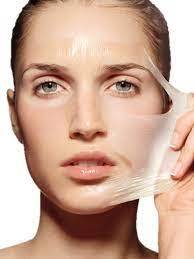
How it works
Skin is comprised of two layers. The outer layer is called the epidermis, while the deeper layer is referred to as the dermal layer. Chemical peels work by applying a chemical solution onto the top layer of skin which reacts with the dead skin cells, causing the skin to peel and new skin to form. The exfoliation of dead skin cells on the outer layer of the skin leads to increased production of the structural protein collagen, which, in turn, improves skin tone and texture. The exfoliation of the skin can be superficial or more dramatic depending on the depth of the chemical peel, as medium-depth peels and deep chemical peels can penetrate the dermis or inner layer of the skin. Chemical peels are an extremely popular cosmetic procedure not only due to the many anti-aging benefits of the treatment but also because superficial peels and medium-depth peels require no significant downtime. Superficial peels improve conditions such as acne, mild sun damage, and skin discoloration. Deeper peels which include TCA and phenol peels produce deeper injury within the dermal layer and reverse moderate to-severe photoaging and improve the appearance of fine lines and wrinkles. In general, deeper peels offer the most dramatic results, but require longer recovery periods and carry a higher risk of complications including the potential for infection.
Benefits of Chemical Peels
Exfoliate the outer layer of skin
Reduce the appearance of fine lines and wrinkles
Lighten areas of hyperpigmentation and other discolorations involving the skin
Improve the appearance of UV sun damaged skin, evening out skin tone
Diminish the appearance of acne scarring and other superficial scars
Reduce and resolve acne and blemish breakouts
Control excess oil
Soften rough skin
Treat melasma
Promote a smoother skin texture and more even skin tone
Refresh and invigorate the skin
faqs
A chemical peel solution will be applied to clean skin using a large cotton applicator. A chemical peel works by exfoliating your facial skin to improve texture and tone, resulting in smoother, brighter, clearer skin. The face is the most common treatment zone, but the hands and neck can also be restored to a more youthful, fresh appearance with a chemical peel.
Some of our medical-grade peels produce a mild stinging sensation. Cold compresses or cold air can be used to minimize discomfort. Remaining redness, skin peeling, or irritation typically clears after a few days. The symptoms often reduce with repeated treatments.
A soothing ointment or cream is applied, and Dr Hudson will advise the best methods of supporting your new glowing, luminous skin, including modifying your daily skincare routine.
Some peels can cause mild redness, crusting, and stinging for a few days following a treatment. Redness, skin peeling, or irritation typically clear after a few days. These symptoms often diminish with repeated treatments.
After a few days, your skin will look noticeably fresher, smoother, and more youthful looking. For more intense treatments, you may experience minor swelling or a sensation of tightness. We advise keeping the skin moisturized as the skin continues to peel. Please be aware that not while you may not experience visible peeling after undergoing a chemical peel, the chemical peel is working effectively removing the outer layer
of your skin. Treated skin is more sensitive to the sun, so the use of sunscreen and avoidance of sun exposure are paramount.
Chemical peels are an excellent means of preparing the skin for laser resurfacing treatments and improving the outcome of those procedures as well.
types of peels
Regenesis Medical Spa offers an assortment of chemical skin peels ranging from superficial to medium grade. These different chemical peels produce various degrees of penetration to the skin After evaluating your specific skin condition and concerns, Dr Hudson will select the best chemical peel choice for your skin based upon your specific skin type and desired results.
results

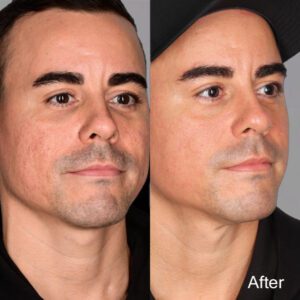
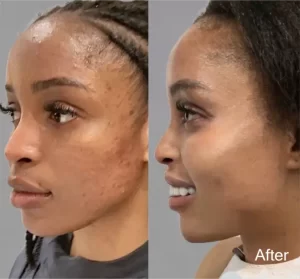

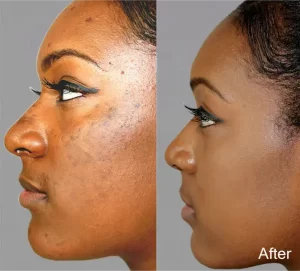
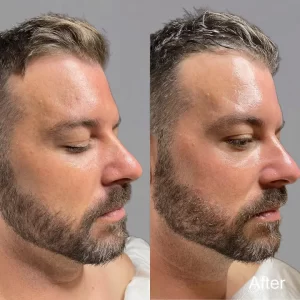
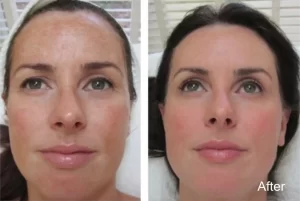
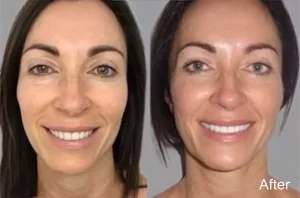

*Individual results may vary with different patient experiences.
*A series of treatments may be required for desired results.
